John Surtees was first, and remained foremost, a racing motor cyclist; he was virtually born one. While still under regulation minimum age, he was riding as passenger in the racing sidecar piloted by his father, Jack. Things were not made easy for him: he was taught to work hard, and he never stopped.
The Vincent Motor-Cycle Company and the Grey Shadow
Born in 1934 in Kent in the UK, when he left school he was apprenticed to the Vincent motor-cycle company, and he built for himself what must have been one of their most successful bikes, a 500cc short-circuit racer which became known as the Grey Shadow. On it he gained his first victory in a race at Brands Hatch in 1951, his first year as a solo racer. On the track and off it, John Surtees continued to work hard, scratching successfully around all the British short circuits where courage and track craft were bred, and rapidly developing both qualities to an exceptional degree.
Before long, it was clear that his abilities exceeded the potential of the Vincent, and he acquired a Norton. This hyper-developed machine had a far higher performance and inherently better handling than the Vincent, but its ground clearance was less and Surtees at first found himself in difficulties. Using his impressive skills Surtees invented a new riding technique: unable to bank his Norton as far as he wished in corners, he leaned over on the inside of the bend, shifting the combined centre of gravity of bike and rider further than the bike itself could be tilted. It worked, and was cultivated to extremes by other riders; but it was something to offend the purists because it was untidy.
Geoffrey Duke
In those days, the greatest rider, the only one to elevate motor-cycle racing to an art form, was Geoffrey Duke, who was the epitome of smooth and stylish riding, seeming not to move on his mount except to raise his head a little on the way into a corner. After a couple of seasons, by which time Duke had moved on from leading the works Nortons to winning more world championships for Gilera, Surtees took him on and beat him, not only at Surtees home circuit of Brands Hatch, but also at other British short circuits. His fans, overlooking the unsuitability of the four-cylinder Gilera for these particular tracks, went wild with enthusiasm, and "Big John" was on his way.
MV Agusta
In 1955 Surtees joined the Norton team, and at the end of that year he signed to ride for MV Agusta, winning the Senior World Championship in 1956 and following through with a hat-trick of double championships. With his combination of riding skill, courage and engineering ability (he had assisted significantly in its mechanical development), he had made the fire-engine the fastest road-racing motor cycle in the world; and with seven World Championships to his credit, he announced his retirement from motor-cycle racing.
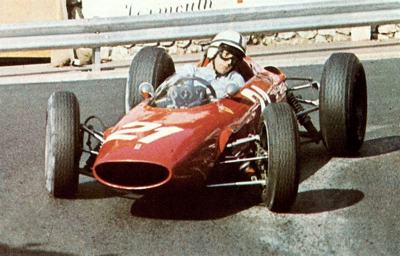 John Surtees at the wheel of the Ferrari 156B at the 1963 Monaco GP.
John Surtees at the wheel of the Ferrari 156B at the 1963 Monaco GP.
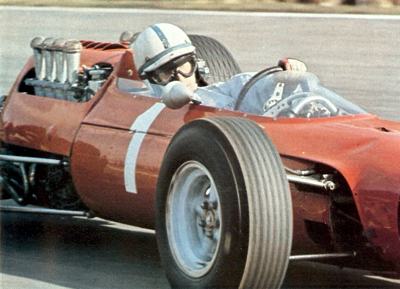 John Surtees behind the wheel of the Ferrari at Brands Hatch in 1965.
John Surtees behind the wheel of the Ferrari at Brands Hatch in 1965.
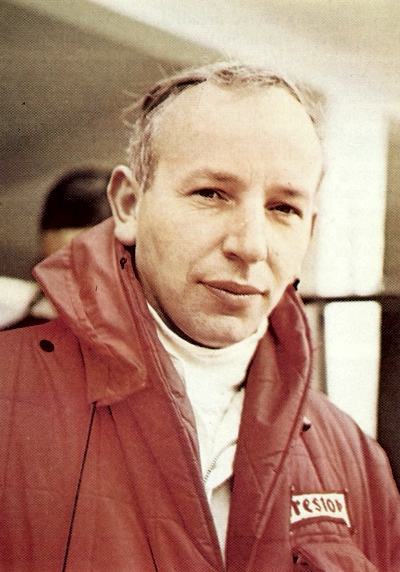 John Surtees.
John Surtees.
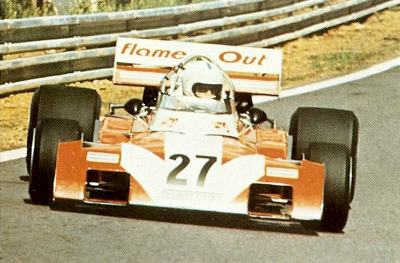 Tim Schenken at the wheel of the Srtees TS9B at Clemont-Ferrand during the 1972 French GP.
Tim Schenken at the wheel of the Srtees TS9B at Clemont-Ferrand during the 1972 French GP.
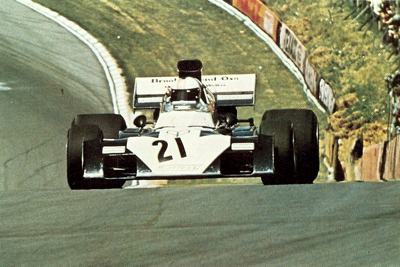 Mike Hailwood at the wheel of a 1972 Surtees TS9B.
Mike Hailwood at the wheel of a 1972 Surtees TS9B.
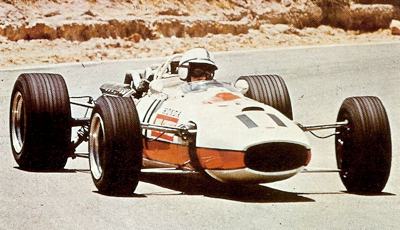 George Follmer in the Can-Am Porsche 917/10 at Watkins Glen during 1973.
George Follmer in the Can-Am Porsche 917/10 at Watkins Glen during 1973.
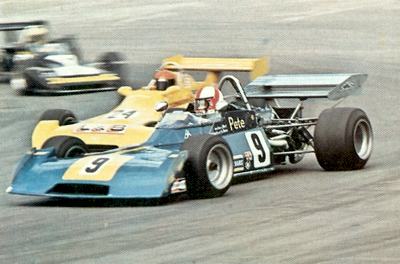 Peter Wardle in the Formula Atlantic Surtees TS15 at Mallory Park in 1975.
Peter Wardle in the Formula Atlantic Surtees TS15 at Mallory Park in 1975.
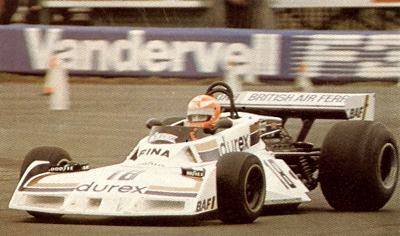 The Surtees TS19 with Rupert Keegan driving at the Daily Express International Trophy meeting at Silverstone in 1978.
The Surtees TS19 with Rupert Keegan driving at the Daily Express International Trophy meeting at Silverstone in 1978.
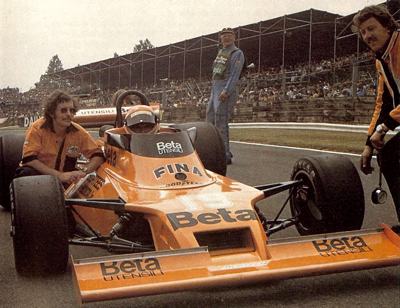 Vittorio Brambilla in the Surtees TS20 at Brands Hatch for the 1978 British Grand Prix. The TS20 was introduced mid-way through the 1978 season and incorporated numerous changes, the most noticeable being the new pointed nose section.
Vittorio Brambilla in the Surtees TS20 at Brands Hatch for the 1978 British Grand Prix. The TS20 was introduced mid-way through the 1978 season and incorporated numerous changes, the most noticeable being the new pointed nose section. |
He had already tried his hand in racing cars, first at the invitation of Reg Parnell, who invited him to join the Aston Martin team. Surtees tried the car at Goodwood, did well, but declined the offer, saying that he did not want to start so near the top. He also tried the rear-engined Grand Prix Vanwall, and in 1960 drove a Formula Junior Cooper for Tyrrell. Then he bought a Formula II Cooper, and was given a couple of drives in a Formula I Lotus by
Colin Chapman. At Silverstone for the British GP, Surtees finished second, just four months after his first motor race; but still he would not sign for a works team.
For two years Surtees drove Coopers and Lolas for Yeoman Credit and Bowmakers, under the tutelage of Parnell, even refusing the invitation to drive for Ferrari. When he knew himself to be ready for the big time, he accepted Ferrari's repeated offer, and joined the Italian team for the 1963 season. Again, he toiled as development engineer as well as driver, working doggedly on the new V6-engined car, the Grand Prix Dino 156, to such good purpose that he won the German, Mediterranean and Rand Grands Prix, as well as sharing two long-distance sports-car victories, finishing the season in fourth place in the World Championship.
The First World Champion on Two and Four Wheels
The following year, after victories at the
Nurburgring and at Monza, Surtees won the Championship. He had proved his point, and had made himself the first World Champion on two wheels and four. Other racing motor cyclists had tried car racing; some like Duke had failed, others - mostly of an earlier generation such as Caracciola, Nuvolari and Rosemeyer, but also more recently such as Siffert, and Surtees' own protege Hailwood who had followed him into the MV Agusta team - had been very successful. Nevertheless, it was only Surtees who reached the top in both.
Serious Injuries at Mosport
During all this time Surtees had not allowed his association with Eric Broadley, the designer of Lola cars, to lapse. With his commitments to Ferrari limited to single-seaters and the long-distance sports-car races for the Manufacturers' Championship, he was free to race and help in the development of the Group Seven sports car, which became known as the T70 Lola. At this time high=powered sports cars in this category were attracting considerable attention, especially in the Can-Am series of races; and it was at Mosport that Surtees suffered the only really serious racing accident of his career. A suspension upright broke, and the Lola crashed violently, causing Surtees extensive injuries so serious that his career - and his life - was in great danger for some time.
Throughout the winter and the spring, Surtees devoted all his furious concentration, his indomitable willpower and his dogged courage to the impossible task of recovering his health and fitness. It was his greatest and hardest earned victory, and he confirmed it by resuming his seat in a racing car again at no less taxing an event than the 1000 kilometres sports-car race at Monza - an event that he won, with co-driver Michael Parkes, in torrential rain with a faulty screen wiper on the big 330 P3 Ferrari. He won in the wet for Ferrari again at Spa in the Belgian Grand Prix, in the new V12 car with which he had started the new three-liter formula by winning at Syracuse and being fastest in practice at Monaco.
The Spa race was to be Surtees' last for Enzo Ferrari: the two men were very fond of each other, but the Surtees personality clashed violently with that of team manager Dragoni. Things came to a head during practice for the
Le Mans race of 1966, when Dragoni professed doubts about Surtees' fitness-despite the compelling evidence to the contrary - and entered a third reserve driver for the car Surtees had been scheduled to drive. In retrospect, this must be seen as the occasion rather than the cause of Surtees' resignation from the Ferrari team, but there was no doubt of that resignation being complete and final as Surtees called a press conference in the paddock to announce what he had done.
Had he stayed with Ferrari, he would probably have won himself another World Championship. As it was, in mid-season he had to hunt around for a drive, and finally came to roost with the Cooper team who were campaigning their new, heavy and evidently very ungainly Maserati-engined car. At the
Nurburgring for the German GP, Ferrari saw Surtees put it on the front row of the grid, and bring it home in a damp second place behind a flying
Brabham who that year was having perhaps his best and certainly his luckiest season. Surtees was having to work much harder for his success but he managed to transform the Cooper from a car with severe handling deficiencies to one that was capable of using more power than it had.
Low Profile Firestones
One of the things that contributed to this change was his choice of the new low-profile Firestone tires, in place of the older-fashioned Dunlops on which, or despite which, the Cooper had been designed. Surtees was very tire-conscious, and his experience with the Can-Am cars undoubtedly taught him a lot in this respect, as well as his former days on the Vincent and Agusta. He formed a very friendly relationship with Firestone at about this time.
As the 1966 season drew to its close, Surtees won the Mexican GP, something that nobody would have thought possible of a Cooper earlier in the year. It was his second impossible achievement in twelve months, and he gave us a reminder of his first by taking a Mk II Lola T70 through the Can-Am series to emerge as the overall winner. In 1967, he turned a heavyweight Honda V12 into an effective and successful Grand Prix car. Its engine was brilliant; the rest of it was pretty average. Including the conditions under which Surtees worked; admittedly, he was supplied with Japanese mechanics, but he was forced to work a long distance from the factory design staff, which was not ideal.
But his hard work and determination paid off with a superb victory at Monza in 1967. It was one of the greatest races in the history of the sport, one in which the late Jim Ciark put up one of the most incredible performances of his career, only to run out of petrol on the last lap. Close behind him (so close that they nearly ran down Colin Chapman, who was looking for Ciark to take the chequered flag) came Surtees and Brabham, the old master of tactics and proprietor of the year's most successful racing car. With one crucial corner left, Surtees tricked Brabham with an increduble dummy manouvere, leaving him all crossed up and nowhere to go, while Surtees slipped across behind him to take the lead and hold it grimly to the finish.
Team Surtees
After another year persevering fruitlessly with Honda, Surtees joined the BRM team, hoping to make the P153 car race-worthy. The best he managed was third place in the US GP, but neither the organisation nor the vehicle seemed to match the standards to which he had once been accustomed. Already he had developed substantial business interests, and now he established Team Surtees as car manufacturers as well as entrants. Having severed his connection with Lola, Surtees went to the designer Leonard Terry to ask for a Formula 5000 design. Terry had one already developed for Roger Nathan but not taken up; and with slight modifications to satisfy Surtees' critical eye this car, the Terrier Mk 15, became the Mk 17, and thenc evolved into the Surtees TS5.
The full monocoque hull was similar to that of the last racing Honda, for Terry had (with the Japanese company's approval) built the last chassis for Surtees to race in 1968. One of the characteristics of this hull was its single-curvature skin, which allowed the use of high-strength aluminum alloy, thus keeping the weight to a minimum. One of the few unusual features of the car was the wheel design, again the work of Terry, and similar to one used on a Lola chassis that Surtees briefly drove for BMW, powered by their radial-valve Apfelbeck engine. The TS5 was almost immediately successful in competition, Trevor Taylor and David Hobbs winning most of their races on both sides of the Atlantic by the end of the 1969 season.
Alan Rollinson and Mike Hailwood
It was followed by the TS7 Formula one car, which Surtees often drove himself, having kept his hand in meanwhile with a McLaren he had bought. The TS8 was another Formula 5000 car which earned major victories in 1971 for Alan Rollinson and another (perhaps even more outstanding) motor cyclist, Mike Hailwood. The latter came second in the 1972 Tasman Championship driving a developed version of this car, and its successor the TS11 was similarly successful. Surtees and Hailwood were joined by Schenken and occasionally others, in Formula One and Two Surtees cars (TS9 and 10 respectively) in those same years, and the cars occasionally showed considerable promise. There was really nothing special about them, they were Cosworth-engined just like most of the others in contention, but they were turned out impeccably.
The TS14 and the full-width 15, which appeared at the end of 1973, looked even more promising - but when practically the entire team of cars was later wrecked in the first-lap crash at the British Grand Prix, the team came near to ruin. However, the industrious and persevering Big John had survived more acute disasters than that, and he did it again, but although the 1975 cars showed some promise the best result was Watson's fourth place in the Daily Express International Trophy race, a non-championship event at Silverstone. 1976 was a better year for the team;
Alan Jones was a very close second behind James Hunt in the Race of Champions at Brands Hatch and the cars ran consistently, if unspectacularly, in middle field at most Grands Prix.
Vittorio Brambilla
Vittorio Brambilla joined Surtees in 1977 and achieved creditable results of fourth, fifth and sixth at the Belgian, German and Canadian Grands Prix respectively, to come fifteenth in the championship, while Team Surtees was only eleventh in the constructors' cup. Surtees' drivers for 1978 were Brambilla and Rupert Keegan, who added his father's British Air Ferries sponsorship to that of the London Rubber Company (Durex) which Surtees had had for some years. Success, however, continued to elude Surtees in the 1978 season. Brambilla proved consistently quicker than team mate Keegan, although it was not until the two-thirds stage of the season that he managed to get into the points, with sixth place in Austria.
In May 1978 a new Surtees was unveiled in time for the Monaco Grand Prix. The TS20 was longer and wider than its predecessor the TS1I9. The triangular monocoque used, while similar to that of the TS19, was claimed to be some 17 per cent stiffer. The major revisions visually were the removal of the air-box, and the addition of a new, more pointed, nose which replaced the previous full-width front on the TS19. The oil cooler was mounted in the nose, and the radiators moved back and laid alongside the engine. According to John Surtees, changes were made in the TS20 to maximize the performance of the Goodyear tires available to the team. These changes included altering the weight distribution and increasing both track and wheelbase. The change from TS19 to TS20 did not improve materially the performance of the team, and in fact the new car did not seem to suit Keegan who spent more and more time as a Grand Prix spectator after failing to qualify for several races and being injured in a Dutch practice accident.
For a while in the 1970s Surtees ran a motorcycle shop in West Wickham, Kent. He continues his involvement in motorcycling, participating in classic events with bikes from his stable of vintage racing machines. He remained involved in single-seater racing cars and held the position of chairman of A1 Team Great Britain, in the A1 Grand Prix racing series from 2005 - 2007. His son, Henry competed in the FIA Formula 2 Championship, Formula Renault UK Championship and the Formula BMW UK championship for Carlin Motorsport, before he died whilst racing in the Formula 2 championship at Brands Hatch on 19 July 2009.
In 1996, John Surtees was inducted into the International Motorsports Hall of Fame. The FIM honoured him as a Grand Prix "Legend" in 2003. Already a Member of the Order of the British Empire (MBE), he was appointed Officer of the Order of the British Empire (OBE) in the 2008 Birthday Honours.
